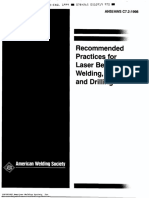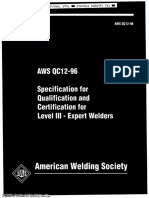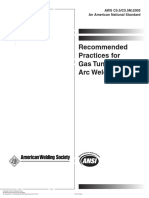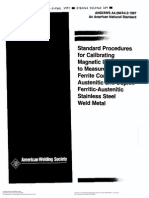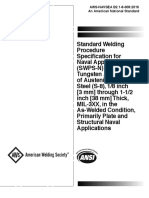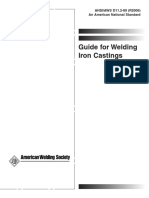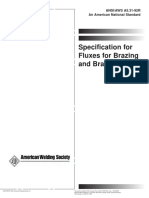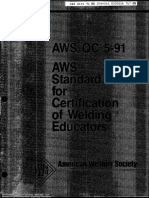Aws C7.3-1999
Uploaded by
Rene Alfonso BeltranAws C7.3-1999
Uploaded by
Rene Alfonso BeltranSTD.AWS C7.3-ENGL 1999 . . 0784265 0512178 Tbb . .
AWS C7.3:1999
An American National Standard
Process
Specification for
Electron Beam
Welding
........
~--
Copyright by the American Welding Society Inc
Thu Sep 27 08:50:00 2012
STD-AWS C7.3-ENGL 1~~~ . . 0784265 0512179 ~T2 ..
Key Words- Electron beam welding, high thermal AWS C7.3:1999
conductivity materials, high-power An American National Standard.
density welding, refractory materials.
keyhole mode welding, deep· Approved by
penetration welding
American National Standards Institute
July 12, 1999
Process Specification for
Electron Beam Welding
Prepared by
AWS Committee on High-Energy Beam Welding and Cutting
Under the Direction of
AWS Technical Activities Committee
Approved by
AWS Board of Direclurs
Abstract
This specification on electron beam welding discusses applicable specifications, safety, requirements, fabrication, qual-
ity examination, equipment calibration and maintenance, approval of work, and delivery of work.
Copyright by the American Welding Society Inc
Thu Sep 27 08:50:09 2012
STD-AWS C?.3-ENGL 1~~~ . . 0784265 0512180 614 . .
Statement on Use of AWS Standards
All standards (codes, specifications, recommended practices, methods, classifications, and guides) of the American
Welding Society are voluntary consensus standards that have been developed in accordance with the rules of the Ameri-
can National Standards Institute_ When AWS standards are either incorporated in, or made part of, documents that are
included in federal or state laws and regulations, or the regulations of other governmental bodies, their provisions carry
the full legal authority of the statute. In such cases, any changes in those AWS slandards must be approved by the gov-
ernmental body having statutory jurisdiction before they can become a part of those laws and regulations. In all cases,
these standards carry the full legal authority of the contract or other document that invokes the AWS standards. Where
this contractual relationship exists, changes in or deviations from requirements of an AWS standard must be by agree-
ment between the contracting parties.
International Standard Book Number: 0-87171-586-4
American Welding Society, 550 N.W. LeJeune Road, Miami, FL 33126
© 1999 by American Welding Society. All rights reserved
Printed in the United States of America
Note; The primary purpose of AWS is to serve and benefit its members. To this end, AWS provides a forum for the ex-
change, consideration, and discussion of ideas and proposals that are relevant to the welding industry and the consensus
of which forms the basis for these standards. By providing such a forum, AWS does not assume any duties lo which a
user of these standards may be required lo adhere. By publishing this standard, the American Welding Society does not
insure anyone using the information it contains against any liability arising from that use. Publication of a standard by
the American Welding Society does not carry with it any right to make, use. or sell any patented items. Users of the in-
formation in this standard should make an independent, substantiating investigation of the validity of that information
for their particular use and the patent status of any item referred to herein.
Official interpretations of any of the technical requirements of this standard may be obtained by sending a request, in
writing, to the Managing Director Technical Services, American Welding Society, 550 N.W. LeJeune Road, Miami, FL
33126 (See Annex G). With regard to technical inquiries made concerning AWS standards, oral opinions on AWS stan-
dards may be rendered. However, such opinions represent only the personal opinions of the particular individuals giving
them. These individuals do not speak on behalf of AWS, nor do these oral opinions constitute official or unofficial opin-
ions or interpretations of AWS. In addition, oral-opinions are informal and should not he u...;;ed as a substitute for an offi-
cial interpretation.
This standard is subject to revision at any time by the AWS Committee on High Energy Beam Welding and Cutting. It
must be reviewed every five years and if not revised, it must be either reapproved or withdrawn. Comments (recommen-
dations, additions, or deletions) and any pertinent data that may he of use in improving this standard are requested and
should be addressed to AWS Headquarters. Such comments will receive careful consideration by the AWS Committee
on High Energy Beam Welding and Cutting and the author of the comments will be inrormed of the Committee's re-
sponse to the commenls. Guests are invited to attend all meetings of the AWS Committee on High Energy Beam Weld-
ing and Cutting to express their comments verbally. Procedures for appeal of an adverse decision concerning all such
comments are provided in the Rules of Operation of the Technical Activities Committee. A copy of these Rules can be
obtained from the American Welding Society, 550 N.W. LeJeune Road, Miami, FL 33126.
Pboto<:opy Rights
Authorization to photocopy items for internal. personal, or educational classroom use only, or the internal, personal, or
educational classroom use only of specific clients, is gran led by the American Welding Society (AWS) provided that the
appropriate fee is paid to the Copyright Clearance Center, 222 Rosewood Drive, Danvers, MA 01923, Tel: 978-750-8400;
online: http://www.copyright.com
Copyright by the American Welding Society Inc
Thu Sep 27 08:50:10 2012
STD.AWS C?.3-ENGL 1,,, . . 07842b5 0512181 550 . .
Personnel
AWS Committee on High-Energy Beam Welding and Cutting
D. E. Powers, Chair PTR- Precision Technologies, Incorporated
R. J. Steele, 1st Vice-Chair Naval Air Warfare Center
D. D. Kautz, 2nd Vice-Chair Los Alamos National Laboratory
E. F Mitchell, Secretary American Welding Society
E.D.Bmndon Sandia National Laboratories
R. D. Dixon Los Alamos National Laboratory
*W. 1. Farrell, Sr. Consultant
P. W. Fuerschbach Sandia National Laboratories
*R.A. Huber Consultant
*C. A. Johnson Naval Air Warfare Center
V. E. Merchant Consultant
R. W Messler, .Jr. Rensselaer Polytechnic Institute
'T. M. Mustaleski Martin Marietta Energy Systems
R. C. Salo Sciaky, lncorporateU
L. Weeter Motoman, Incorporated
AWS Subcommittee on Electron Beam Welding and Cutting
D. D. Kautz, Chair Los Alamos National Laboratory
D. E. Powers, Vice-Chair PTR-Precision Technologies, Incorporated
E. F. Mitchell, Secretary American Welding Society
E. D. Brandon Sandia National Laboratories
G. R. Cannell Westinghouse Savannah River Company
R. D. Dixon Los Alamos National Laboratory
R. V. Dynak Pratt and Whitney, Eagle Services
* W. J. Farrell, Sr. Consultant
D. R. Foster Pratt and Whitney Aircraft
'R. A. Huber Consultant
*G. S. Lawrence Brunson Instrument Company
E. D. Levert, Sr. Lockheed Martin Vought Systems
B. J. MacFaddin International Beam Welding Corporation
J. 0. Milewski Los Alamos National Laboratory
*T. M. Musta/eski Martin Marietta Energy Systems
R. C. Salo Sciaky, Incorporated
K. J. Zacharias HSD Space Systems International
*K. T. Zy>k USAF/AEDC/DOTF
"'Advi!iOJ
Ill
Copyright by the American Welding Society Inc
Thu Sep 27 08:50:11 2012
STD.AbiS C?-3-ENGL 1'1'1'1 • 0?84265 0512182 4'1? •
Foreword
(This Foreword is not a part of AWS C7.3: 1999, Process Specification for Electron Beam Welding, but is included for
information purposes only).
Electron beam processing was initiated in the early 1900s, when an electron beam was used to produce tantalum
metal by melting tantalum sponge. Sin~e then, elet.:tron beam technology for material processing has steadily advanced.
Comments and suggestions for the improvement of this standard are welcome. They should be sent to the Secretary
C7, Committee on High Energy Welding and Cutting. American Welding Society, 550 N.W. LeJeune Road, Miami, FL
33126.
Official interpretations of any of the technical requirements of this standard may be obtained by sending a request. in
writing, to the Managing Director, Technical Services, American Welding Society. A formal reply will be issued after it
ha~ been reviewed by the appropriate personnel following established procedures.
iv
Copyright by the American Welding Society Inc
Thu Sep 27 08:50:12 2012
STD·AWS C7·3-ENGL ~999 . . 0784265 0512183 323 . .
Table of Contents
Page No.
Personnel ................................................................................................................................................................... iii
Foreword ...................................................................................................................................................................... iv
List of Tables ................................................................................................................................................................ vi
I. Scope ..................................................................................................................................................................... !
1.1 Materials ........................................................................................................................................................ !
1.2 Qualification Categories ............................................. ".................................................................................. !
2. Applicable Specifications ...................................................................................................................................... 1
2.1 ANSI Documents ........................................................................................................................................... I
2.2 AWS Documents ............................................................................................................................................ !
2.3 MSDS ............................................................................................................................................................. I
2.4 AVS Documents ............................................................................................................................................ 1
3. Safety ...................................................................................................................................................................... 1
3.1 Electric Shock ................................................................................................................................................ 2
3.2 Materials, Fumes, and Gases .......................................................................................................................... 2
3.3 X-Radiation .................................................................................................................................................... 2
3.4 Visible Radiation ............................................................................................................................................ 2
3.5 Vacuum .......................................................................................................................................................... 2
3.6 Mechanical Systems ....................................................................................................................................... 2
4. Requirements ....................................................................................................................................................... 2
4.1 Equipment ...................................................................................................................................................... 2
4.2 Materials ......................................................................................................................................................... 3
4.3 Joint Design .................................................................................................................................................... 3
4.4 Preweld and Postweld Heat Treatments ......................................................................................................... 3
4.5 Procedures .................................................................................................................................................... 3
5. Fabrication .............................................................................................................................................................. 4
6. Quality Examination ............................................................................................................................................... 4
6.1 Nondestructive Examination (NDE) ............................................................................................................. .4
6.2 Discontinuily Limits ...................................................................................................................................... 4
6.3 Destructive Evaluation ................................................................................................................................... 4
7. Equipment Calibration and Maintenance.................................................................................................... ..4
8. Approval of Work ................................................................................................................................................. 4
9. Delivery of Work .................................................................................................................................................. 4
9.1 Identification ................................................................................................................................................ 4
9.2 Protective Treatments ..................................................................................................................................... 4
9.3 Packaging ...................................................................................................................................................... 4
Annex A -Preweld Cleaning Processes vs. Materials ............................................................. .................................... 5
Annex B-Sample WPS .. ............................................................................................................................................... 6
Annex C-Sample Welding Procedure Qualification Record (WPQR) ........................................................................ 7
Annex D-Samp/e Operator Process Qualification Test Record (OPQTR) ................................................................. 8
Annex £--Sample Operational Review ........................................................................................................................ 9
Annex F---Nondestructive Evaluution Discontinuity Limits ....................................................................................... 10
Annex G-Cuidelines for Preparation ofTechnicaJ Inquires for AWS Technical Committees .................................. 11
Copyright by the American Welding Society Inc
Thu Sep 27 08:50:14 2012
STD.AWS (7.3-ENGL 1999 . . 0784265 0512184 26T . .
List of Tables
Table Page No.
Nondestructive Examination···-·-·-·-···--·--·------· ............................................................................................... 4
VI
Copyright by the American Welding Society Inc
Thu Sep 27 08:50:15 2012
STD.AWS C7·3-ENGL 1999 .. 0784265 0512185 1Tb ..
AWS C7.3:1999
Process Specification for
Electron Beam Welding
1. Scope 2.1 ANSI Documents (American National Standards
Institute, 11 W. 42nd Street, New York, NY 10036-8002)
This specification addresses processing and quality
control requirements for electron beam welding. Pro~ 2.1.1 ANSI Z49.1, Safety in Welding, Cutting, and
cessing includes both- high~ and low-voltage welding Allied Processes
equipment and high and medium vacuum variations. 2.1.2 ANSI Z87.1, Occupational and Educational
1.1 Materials. This specification covers all major engi- Eye and Face Protection
neering alloys including:
2.2 AWS Documents (American Welding Society, 550
1.1.1 Ferrous Alloys (steels and stainless steels)
N.W. LeJeune Road, Miami, FL 33!26)
1.1.2 Aerospace Alloys (AI alloys, Ti alloys,
superalluys) 2.2,1 AWS A2.4, Standard Symbols for Welding,
Brazing, and Nondestructive Exami11ation
1.1.3 Heat-Resisting Alloys (refractory metal alloys)
1.1.4 Other Metals (Cu alloys, Be alloys, precious 2.2.2 AWS A3.0, Welding Terms and Definitions
metals) 2.2.3 AWS B2.1, Standard for Welding Procedure
1.2 Qualification Categories. There are three catego· and Performance Qualification
ries to which welds may be qualified: Class A, B, or C. 2.2.4 AWS C7.1, Recommended Practices for Elec~
1.2.1 Class A-Critical Applications. Critical weld- lrun Ream Welding
ments include those where a failure of any portion would
cause loss of system, loss of major component, loss of 2.3 MSDS. Material Safety Data Sheet, available from
control, unintentional release or critical stores (such as producer of chemical or other materiaL
fuel or cargo), or endangerment of personneL
2.4 AVS Documents (American Vacuum Society, 120
1.2.2 Class B-Semicritical Applicatiuns. Semi· Wall Street, 32nd Floor, New York, NY 10005)
critical weldments include those where a failure would
reduce the overall efficiency or the system but loss of American Vacuum Society Vacuum Hazards Manual
the system or endangerment of personnel would not be
experienced.
1.2..3 Class C-Noncritical Applications. Noncriti- 3. Safety
cal weldments include those where a railure would not
affect lht: ~::ffidency of the system or endanger personnel. These safe practice recommendations are abstracted
from AWS C7.1. That document and the manufacturer's
manuals should be consulted for a more complete treat~
ment of the subject. The following potential hazards are
2. Applicable Specifications
associated with electron beam welding: electric shock,
The following publications form a part of this specifi· toxic or hazardous materials (e.g. cleaning solutions, sol~
cation to the extent specified herein. The latest issue of vents, etc.), fumes and gases, X·radiation, visible radia·
all specif1cations shall apply. tion, and vacuum.
Copyright by the American Welding Society Inc
Thu Sep 27 08:50:16 2012
STD·AWS C7·3-ENGL 1999 II 078~265 0512186 032 . .
AWS C7.3:1999
3.1 Electric Shock. The typical primary voltage to an 3.5 Vacuum. All electron beam welding machines cov-
electron beam welding machine is 440 volts AC. That ered by this document use vacuum pumping to protc:::ct
voltage is stepped up to several thousand volts for the the beam during transmission and to prevent degrading
electron beam gun and also for the vacuum (ionization) of the workpiece.
gauge(s). These voltages, and their associated currents, The American Vacuum Society Vacuum Hazards
can be lethal. Manual can be consulted for appropriate safety precau~
tions when working with vacuum systems on electron
3.1.1 All doors and access panels on electron beam
beam welding equipment.
welding equipment shall be properly secured and interw
locked to prevent accidental or unauthorized access. 3.6 Mechanical Systems. Follow appropriate lock-out
and tag~out procedures when servicing electron beam
3.1.2 All conductors shall be fully enclosed by
equipment.
grounded, conductive barriers that are also interlocked.
3.1.3 A grounding probe must be used before servic-
ing the electron beam gun and high voltage power supply.
3.1.4 Appropriate warning signs shall be affixed to 4. Requirements
the equipment per ANSI Z49. I.
This section discusses requirements to be met before
3.1.5 Follow appropriate lock-out and tag~out proce- welding qualification to this specification is allowed.
dures when servicing eleclron beam equipment.
4.1 Equipment. Equipment falls into two categories: (1)
3.2 Materials, Fumes, and Gases. Ozone, nitrogen ox- the electron beam welding machine and associated hard·
ides, and metal vapors are generated by electron beam ware, and (2) the fixturing and tooling used to make
welding. weldments on specific parts and assemblies.
3.2..1 Exhaust venting and filtering shall be provided 4.1.1 Electron Beam Welding Macbine. This spcci·
for vacuum processing. fication pertains only to welding applications utilizing
high and medium vacuum electron beam welding ma-
3.2.2 Hazardous levels of cleaning solution and solvent
chines defined in AWS A3.0 and AWS C7.1.
vapors shall not be allowed to a~umulate while cleaning
the vacuum chamber for high vacuum processing. 4.1.1.1 Welding equipment shall be capable of
producing acceptable weldments when operated by a cer-
3.2.3 Material Safety Data Sheets (MSDS) shall he
tified operator pursuant to 4.5.4.
read to delermine hazards in working with all materials
associated with the welding process. MSDS shall be fol~ 4.1.1.2 The vacuum chamber or welding enclosure
lowed. These include the MSDS for materials contained cleanliness shall be maintained so that no contamination
in the workpieces, fixturing, and cleaning materials. is transferred to the weldment during welding.
3.3 X-Radiation. X-radiation is produced by electron 4.1.1.3 All equipment shall meet calibration pro-
beam welding equipment during operation. The :system cedures noted in Se<"tion 7.
design incorporates shielding which reduces the radia-
tion to required levels. 4.1.1.4 At appropriate intervals. a welding equip~
ment readiness check, as listed in the Welding Procedure
3.3.1 Proper shielding shall be employed to protect
Specification (WPS), shall be made to verify that equip·
personnel from X-ray leakage.
ment is in proper working order.
3.3.2 Equipment shall be inspected and a radiation
4.1.2 Fixturing and Tooling. This section addresses
survey shall be conducted periodically to ensure that
the fixturing and tooling design for electron beam
shielding is performing properly.
welding.
3.3.3 All users of the equipment shall establish and
4.1.2.1 To avoid problems with beam deflection,
adhere to a radiation safety program.
all fixturing should be non·magnetic where practical. At
3.4 Visible Radiation. Direct viewing of the weld area intervals to be noted in the WPS, the levels of residual
during welding can expose personnel to visible, infrared, magnetism of the tooling shall be monitored. If mag~
and ultraviolet radiation. Appropriate optical filters shall netism exceeds the allowable level noted in the WPS.
be used per ANSI Z87.1 to shield personnel from visible degaussing operations must be accomplished to restore
and ultraviolet light exposure. an acceptable level.
Copyright by the American Welding Society Inc
Thu Sep 27 08:50:17 2012
STD-AWS C7.3-ENGL 1999 • D7842bS 0512187 T79 •
AWS C7.3:1999
4.1.2.2 All fixturing should be made from materi- and qualified procedures covering deviations from the
als that will not affect weld or base metal quality through above specifications such as weld rework or repair proce-
contact (either directly or via spatter). All tooling shall dure specifications. Two categories of qualified welding
be cleaned to ensure no contamination i~ introduced into procedures are referred to in this section: Procedures
the weldment. qualified using(!) standard qualified weldments and (2)
special test wcldments.
4.1.2.3 All tooling and fixturing shall meet cali-
bration procedures noted in Section 7. 4.5.1 Welding Procedure Development. This sec-
tion addresses the procedures required to make, rework,
4.2 Materials. This section addresses the materials used
or repair welds.
during electron beam welding.
4.2.1 Base materials shall be specified in the refer- 4.5.1.1 Production \\'"elding Procedures shall be
ence tlocument (these include contract, spedfkation, qualified in accordance with AWS 82.1. Welds shall be
blueprint, etc.). qualified with standard test wcldment!':. When specified
by the reference document, special test weldments may
4.2.2 Filler materials, when required, shall be speci- he used for procedure qualification tests and shall be
fied in the reference document or in the WPS. governed by the same limits on variables as standard test
weiUments.
4.2.3 Cleaning materials, chemical solvents, and
etching ~olutions shall be specified in the reference docu- 4.5.1.2 Rework Welding. Criteria for weld rework
ment or in the WPS. Some suggested cleaning materials shall be defined in the reference document or in the WPS.
and methods are noted in Annex A.
4.5.1.3 Repair Welding. A WPS and WPQR shall
4.3 Joint Design. This section addresses typical joints
be prepared for each repair weld.
and tolerancing.
4.3.1 All joints shall be specified in the reference 4.5.2 Welding Procedure Speeification (WPS). All
document and detailed in accordance with AWS A2.4 welds shall be made in accordance with a qualified WPS.
and AWS A3.0. A sample WPS for electron beam welding is shown in
Annex B.
4.3.2 The tolerances for squareness and parallelism
of the faying surfaces shall be specified in the reference 4.5.3 \Velding Procedure Qualification Record
document. Proper tolerances for these parameters are es- (WPQR). The qualification of each welding procedure
sential for the production of acceptable welds. See Sec- shall be documented on a WPQR. A sample WPQR for
tion 8 of AWS C7.1 for more information on acceptance electron beam welding is shown in Annex C. A sample
tolerance levels for electron beam welding. OPQTR is shown in Annex D.
4.3.3 The tolerances for root opening and mismatch 4.5.4 Operator Process Qualification Test Record
shall be specified in the reference document. Proper tol- (OPQTR) Each welding operator shall be qualified in
erances for these parameters arc essential for the produc- accordance with AWS B2.1 prior to any production
tion of acceptable welds. See Section 8 of AWS C7.1 for welding. The documentation of the qualification shall be
more information on acceptance tolerance levels for elec- recorded on a process qualification test record. A sample
tron beam welding.
OPQTR, operator process qualification test record, for
electron beam welding is shown in Annex D. Maintew
4.4 Preweld and Poslweld Heat Treatments. Preweld
and postweld heating are not usually part of the electron nance of welding operator qualification shall follow the
beam welding process. Postweld heat treatments are usu- provision of AWS R2.1 except that the maximum period
ally a separate operation. However, if either is used, es- of inactivity shall not exceed 6 months. Annex U shows
sential parameters shall be specified in the reference typical capabilities expected of an opt:ratur who is quali-
document or WPS. fied to perform electron beam welding.
4.5 Procedures. All weldments shall be fahricated in ac- 4.5.5 Production Welding Records. Documentation
cordance with the reference document hy following the of V..'PS conformance for production welds shall be
WPS qualified and accepted for each type of weld em- maintained for all class A, B, and C welds in accordance
ployed. Required records and documents include the with the reference document. All weld~, class A, B, ami
WPS, the weld procedure qualification record (WPQR), C, shall have a WPS.
Copyright by the American Welding Society Inc
Thu Sep 27 08:50:17 2012
STD-AWS C7·3-ENGL 1999 . . 0784265 0512188 905 . .
5. Fabrication 8. Approval of Work
Fabrication shall be accomplished by personnel quali- The purchaser shall approve the WPS, WPQR. and,
fied per 4.5.4 utilizing a qualified WPS per 4.5.2 and OPQTR before the vendor supplies finished parts.
documented on a WPQR per 4.5.3.
6. Quality Examination 9. Delivery of Work
This section discusses the inspection methods used to This section deals with identification and packaging
determine the quality of the finished weldment. of parts and assemblies by the vendor for shipment to the
purchaser.
6.1 Nondestl"uctive Examination (NDE). The NDE
methods shown in Table 1 shall be applied as indicated. 9.1 Identification. Welded parts or assemblies shall be
Each NDE method shall he performed in accordance identified as specified in the reference document. If no
with a standard. The controlling standanl ~hall be speci- such documentation is available. an agreement between
fied in the reference document. Personnel shall be quali- the vendor and purchaser shall be made as to proper
fied in accordance with ASNT /SNT-TC-1 A Level II or identification.
Ill Examiner or AWS QC-1, as required by Table 1.
9.2 Protective Treatments. When specified in the refer-
6.2 Discontinuity Limits. Discontinuity limits shall be
ence document, a protective treatment shall be applied to
controlled by the reference dncume.nl. Suggested limits
the welded parts or assemblies.
are given in Annex F.
6.3 Destructive Evaluation. Destructive examination 9.3 Packaging. Appropriate packaging shall be used
shall be conducted as specified in the rderence document to protect parts or assemblies during shipment to the
purchaser.
9.3.1 Robustness of Packaging. Welded parts or
7. Equipment Calibration and assemblies shall be handled and packaged to ensure that
Maintenance the intended tolerances and structural integrity of the
parts or assemblies are preserved upon arrival to the
All equipment utilized in qualification and production purchaser.
welding shall he on a maintenance and calibration sched-
ule which assures the equipment performs satisfactorily 9.3.2 Conformance to DOf Regulations. All pack-
on each welding sequence. A typical maintenance and aging and shipping methods shall adhere to the rules and
calibration schedule is discussed in AWS C7.1. regula lions of the U.S. Department of Transportation.
Table 1
Nondestructive Examination
Weld Classification
Examination Method Personnel Qualification A B c
Visual Examination AWSorASNT X X X
Dimensional Examination AWS X X X
Surface Examination ASNT x' X'
Volumetric Examination ASNT X' X'
Leak Testing ASNT X' X' X'
1. Us~ ~i1l1~r Penetrant Examination or Magnetic Particle bam illation.
2. Use either Radiographi-c Examination or Ultra.wnic Examination.
3. Only if specifie<t.
Copyright by the American Welding Society Inc
Thu Sep 27 08:50:18 2012
STD.AWS C7.3-ENGL 1999 . . 0784265 0512189 841 . .
AWS C7.3:1999
AnnexA
Preweld Cleaning Process vs. Materialsa
(Nonmandatory Information)
(This Annex is not a part of AWS C7.3:1999, Process Specification for Electron Beam Welding, but is included for
information purposes only.)
Alloys Degrease Chemical Clean Electropolish Mochanical
I. Ultrasonic cleaning 1. 10% Caustic soda 1 , 10% Caustic 11oda 1. Stainlcs~ wire brush
2. Alcohol 2. 211-50% HNO, 2. 25-70% H2S04 2. Machining
3. HNO,-HF 3. Scrape
Structural Metals
Aluminum Ior2 1 and 2 1,2,and3
Beryllium lor2 2
Cobalt 1 or 2 2
Copper I or 2 2 2 2
High Nickel 1 or 2 2
Mild Steel 1 or 2 2 I and 2
Stainless Steel lor2 2 2
Titaniumb 1 3 2 2
Precious Metals
Gold lor2 2
Platinum lor2 2
P<:~lladium I or2 2
Silver lor2 2
Heavy Metals 1or2 2
Refractory Metals
Molybdenum 1 or 2 2 2
Niobium lor2 3 2
Rhenium lor2 2 2
Tantalum 1or2 3 2
Tungsten 1 or 2 1 and3 2
Vanadium 1 or 2 3 2
Zirconium tor2 3 2
Notes:
a. This table is intended as a guideline and ir1dudes typical prcweld cleaning pnx."C.<,;ses for several common metals. These should not be substhUicd for
established procedures that specify preweld cleaning.
b. Do not degrease titanium with chlorinateJ hydroo:.:arbons or alcohol. Acid etching produces mote even cleaning than electropolishing. Expt".rience
shows that the use or trichloroethylene as a Mllvent on parts or machine components causes problems during corona clear.
Copyright by the American Welding Society Inc
Thu Sep 27 08:50:19 2012
STD.AWS C?.3-ENGl 1~~~ . . 07842b5 05121~0 5b3 . .
AWS C7.3:1999
Annex B
Sample WPS
(Nonmandatory Information)
(This Annex is not a part of AWS C7.3:1999, Process Specification for Electron Beam Welding, but is induded for
information purposes only.)
Weld Procedure Specification for Electron Beam Machine
PART NAME lf!II.RTNUM8ER lOPER. NO JOINT NO. DEPT. NO IAAJ'"L GROUP
MACHINE. NO. lAB NO
OP<AAmR MFG. DEPT. SIJPERVISOI": WE"LD ENGINEEH NIC PflOGRAM.CHANGE L.E'TTffi
~"
MACHINE SETUP FILLER MATERIA-L CIRCLE GENERATION WELD SYMBOL
Gun Type Filler Material Circ~ Generalioo Dia.
Filament Type Color Code Prim.fSec. I CPS/Heat
Filament Size Weld Wire Oiame16f lnctr PulslrlgNv'idth
Filament lo Cathode Distance Wire Speed lpm Freq.
Anode Space Thld\ness
Filament Current (Ref)
Wire Speed Dial Setting
Wire star1 Dela~
'""'
"''·
X-Axis Deflec110n
Y-Axis Deflection
Gun to WOrk D1stance im:h Wire Stop Delay S.o. Straigt-rl
Focus Target Pcs"ion Pralacked/Prepla~ x.v
Beam FoctJs 0 Circle
Beam On Time Pulse Weld Note5: E·EIIipse
ANGLE OF GUN
Table Tih A11gle
Anti Daftoctinn li1be Req'd
Vacuum Prior to Wekl
Time Prior to Vent
WELD AND TRAVEL SETTINGS 1st Pass 2nd Pass 3rd Pass ACTUAL PART SPECFICA.TION
SPOT TACKS POWER % Detail No.
NUMBER Material Spec.
--
Runn1ng Tat:~~ Pow" % Thid<;~ess
L<'lngth Fb:ture No
Number TEST PECE INFORMATION
Mell:lr MA Test Pie<:e No.
"""
·-
Dial Ret M..U.riaiSper:
"''"'" kV ThiOO"loos
Dial Ret Fb:ture No.
"""' Meter
Dial Ref.
TEST RE5ULTS
ACCEPT REJECT NONCONFORMANCE DESCRIPTION
Deflection TyP' Visual
Beam 51~ X NOT
y Dimension
wrLnErnESENTATJVE "NTL 8UI'FRIIIROR WTL STA~P (ACCEPT!I'IEJECn
''""
DlfEICtlon
-
Slopes Up slope
Down slope
Linear •m
Rotary ipm,'rpm Remarks
Diai(Ref)
Comments
Copyright by the American Welding Society Inc
Thu Sep 27 08:50:19 2012
STD.AWS C7·3-ENGL 1999 II 0784265 0512191 4TT . .
AWS C7.3:1999
AnnexC
Sample Welding Procedure Qualification Record
(WPQR)
(Nonmandatory Information)
(This Annex is not a part of AWS C7.3:1999, Process Specification for Electron Beam Welding, but is included for
information purposes only.)
RECORD WPQR # - - - -
TEST RESULTS Part# _ _ __ Weld Procedure# _ _ __
VISUAL INSPECTION
Magnification Used DYes DNa Magnification X
Top Bead 0Smoath 0 Continuous Other
Undercut [lYes []No Location
Cracking DYes DNo Location
Porosity DYes DNo Location
Convexity D Acceptable D Unacceptable Note
Discoloration D Acceptable D Unacceptable Note
Underbead D Acceptable [l Unacceptable Note
Joint Alignment D Acceptable D Unacceptable
Crater/Slope Out D Acceptable D Unacceptable
Test d a t e - - - - - - - - - - - - - - - W~nessed b y - - - - - - - - - - - - - -
NONDESTRUCTIVE TESTING
Dimensional Inspection Report No. _ _ _ _ _ __ Result _ _ _ _ _ _ _ _ _ _ _ _ _ __
Helium Leak Test Report No. - - - - - - - - - Result _ _ _ _ _ _ _ _ _ _ _ _ _ _ __
Radiographic Inspection Report N o . - - - - - - - Result _ _ _ _ _ _ _ _ _ _ _ _ _ _ __
Ultrasonic Inspection Report No. - - - - - - - Result _ _ _ _ _ _ _ _ _ _ _ _ _ _ __
Pressure Test Report No. - - - - - - - - - - Result _ _ _ _ _ _ _ _ _ _ _ _ _ _ __
Dye Penetrant Report No. _ _ _ _ _ _ _ _ __ Result
METALLOGRAPHIC WELD EXAMINATION
Type/No. at Section Transverse # - - - - - Longitudinal # - - - - - Tap # _ _ _ __
Lacalian - - - - - - - - - - - - - - - - - - - - - - - - - - - - - - - - - - - - - - - - - - - -
UNETCHED
;=
Poros~
Cracking
Voids
D
D
D
Acceptable
Acceptable
Acceptable
=
::J
Unacceptable
Unacceptable
Unacceptable
Note------------------
Note-------------------
Nate-------------------
lack of Fusion D Acceptable D Unacceptable Nate------------------
ETCHED
Nme _______________________________
Weld Penetration DIn Spec. [l Out of Spec.
Test d a t e - - - - - - - - - - - - - - - - W~nessed b y - - - - - - - - - - - - - - - -
Copyright by the American Welding Society Inc
Thu Sep 27 08:50:20 2012
STD-AWS C7.3-ENGL 1~~~ . . 0784265 05121~2 336 . .
AWS C7.3:1999
Annex D
Sample Operator Process Qualification Test Record
(OPQTR)
(Nonmandatory Information)
(This Annex is not a part of AWS C7.3;1999, Process Specification for Electron Beam "-'elding, but is included for
information purposes only.)
Identification Number _____________________
Name -------------------------------
Company _____________________________ Dme _________________________________
Type of Welding Machine -----------------------------------------------------------
Welding Procedure Specification# _____________ Rev. - - - - - - - - - - - - - Date-------------
Effective Date ------------------------- Expiration Date _________________________
REQUIRED TRAINING, SPECIFICATIONS, AND PERMITS
Type _________________________________
Safe Operating Procedures (SOP) DYes DNa
Type _________________________________
Specific On-Site Training DYes DNa
~pe _ _ _ _ _ _ _ _ _ _ _ _ ____
Special Work Permits DYes DNa
[]Yes []No Type _______________________________
Material Safety Data Sheets
Welding Procedure Specification # ------------- Rev. _____________
Dale-------------
SCOPE OF QUALIFICATION
Type of Welding Machine(s) -------------------------------------------------------
Type of Material(s) ---------------------------------------------------------------
Type of Parts __________________________________________________________________
Limitations and Exclusions---------------------------------------------------------
TEST RECORD
Actual Part Test Coupons
TEST RESULTS Part# _____________ Weld Procedure Specification # ----------------
VISUAL INSPECTION Result _____________________________
NONDESTRUCTIVE TESTING Result ________________________________
METALLOGRAPHIC WELD EXAMINATION Result _______________________________
DESTRUCTIVE TEST EXAMINATION Resutt _______________________________
We, the undersigned, certify that the statements in this record are correct and that the test welds were prepared, welded,
and tested in accordance with the requirements of the specifications listed above.
Signed _______________________________ Test Date - - - - - - - - - - - - - - - - - - - - - - - - - -
Title-------------------------------
Copyright by the American Welding Society Inc
Thu Sep 27 08:50:21 2012
STD.A~S C7·3-ENGL 1999 .. 0784265 0512193 272 . .
AWS C7 .3:1999
Annex E
Sample Operational Review
(Nonmandatory Information)
(This Annex is not a part of AWS C7.3:1999, Process Specification for Eleclron Beam Welding, but is included for
information purposes only.)
SAMPLE OPERA:f!ONAL REVIEW
Operators should be able to perform all of the following operations satisfactorily before performing welds to this
specification.
1. Perform specified basic operating procedures such as the following:
(1) Change the gun filament.
(2) Corona clear and knee the filament for a given beam current.
(3) Perform beam alignment.
(4) Set the beam focus.
(5) Use the deflection system to form simple patterns on a target or test specimen.
(6) Set the numerical or oomputer control-if available-for a programmed operation.
(7) Operate the mechanical part handling systems including run out platforms which load onto the work table.
(8) Shut down the equipment for both long- and short-tenn shutdowns.
(9) Start up the equipment (enid- and warm-starts).
2. Perform acceptable test welds of basic configurations.
(1) Penetration Studies. Using a focused beam and the proper peaked current, make welds on a coupon or test plate.
Prior to welding, the test block shall be lined up in the chamber sn that the weld will be parallel to the edge of the part.
Make development welds on mock-ups of the appropriate joint configuration.
(2) Nonvertical Joints. Show ability to tilt fixture, gun, or both, to align the beam to nonvertical joints. Also, weld a
blind joint by welding through the base to vertical leg, lining up on ends protruding from each side or along a scribe
mark.
3. Perform an acceptable Operator Process Qualification Test Record (OPQTR)
(1) Development Welding. The operator should weld mock-ups of the production-type weld assemblies using the
proper welding procedure.
(2) Qualitication Tests. When the instructor is satisfied that the operator can qualify to the process, qualification
specimens are welded per the procedure. Test parts are examined and if satisfactory, the qualification of the welding op-
erator is recorded.
Copyright by the American Welding Society Inc
Thu Sep 27 08:50:21 2012
STD·A~S C7·3-ENGL 1~99 . . 0784265 0512194 109 . .
AWS C7.3:1999
Annex F
Nondestructive Evaluation Discontinuity Limits
(Nonmandatory Information)
(This Annex is not a part of AWS C7.3:1999, Process Specification for Electron Beam Welding, but is included for
information purposes only.)
Discontinuity Class A Class B Class C
Surface Porosity
- Individual Size 0.25 Tor 0.030 inch 0.33 Tor 0.060 inch 0.50 Tor 0.090 inch
whichever is less whichever is less whichever is less
-Spacing (minimum) 8 times the s.ize of the larger 4 times the size of the larger 2 times the size of the larger
adjacent discontinuity adjacent discontinuity adjacent discontinuity
-Accumulated Length in any 1 Tor 0.12 inch 1.33 Tor 0.24 inch 2 T or 0.36 inch
3 inches of weld (maximum) whichever is less whichever is less whichever is less
Incomplete Penetration
- Maximum Depth 0.20 Tor 0.030 inch 0.20 Tor 0.050 inch 0.20 Tor 0.050 inch
whichever is less whichever is less whichever is less
Submrface Porosity and [n(lusions
- Individual Size (maximum) 0.33 Tor 0.060 inch 0.50 Tor 0.090 inch Not Applicable
whichever is less whichever is less
-Spacing (minimum) 4 times the size of the larger 2 times the size of the Not Applicable
adjacent discontinuity larger adjacent discontinuity
- Accumulated Length in any 1.33 Tor 0.24 inch 2 Tor 0.36 inch Not Applicable
3 inches of weld (maximum) whichever i!> le!i.!i whichever is less
Undercut
- Full Length of Weld 0.002 inch 0.015 T or 0.002 inch 0.025 Tor 0.002 inch
(maximum depth) whichever is greater whichever is greater
- Individual Defect (maximum 0.070 Tor 0.030 inch 0.10 T or 0.050 inch 0.20 Tor 0.070 inch
depth) whichever is less whichever is less whichever is less
- Accumulated Length in any 0.20 inch 0.60 inch 1.00 inch
3 inches of weld (maximum)
UndertiD and/o[" Concavity
- Full Length of Weld 0.005 inch 0.015 Tor 0.005 inch 0.025 Tor 0.005 inch
(maximum depth) whichever is greater whichever is greater
- Individual Defect 0.070 Tor 0.030 inch 0.10 Tor 0.050 inch 0.20 Tor 0.070 inch
(maximum depth) whichever is less whichever is less whichever is less
- Accumulated Length in any 0.20 inch 0.60 inch 1.00 inch
3 inches of weld (maximum)
Crnters
- Maximum Depth 0.20 T or 0.030 inch 0.20 Tor 0.05 inch 0.20 Tor 0.05 inch
whichever is less whichever is less whichever is less
- Maximum Length IT IT 2T
10
Copyright by the American Welding Society Inc
Thu Sep 27 08:50:22 2012
STD.A~S C7.3-ENGL 1~~~ . . 0784265 0512195 045 . .
AWS C7.3:1999
AnnexG
Guidelines for Preparation of Technical Inquiries
for AWS Technical Committees
(Nonmandatory Information)
(This Annex is not a part of AWS C7.3:l999, Process Specification for Electron Beam Welding. but is included for
information purposes only.)
Gl. Introduction involves two or more interrelated provisions, That provi-
sion must be identified in the Scope of the inquiry, along
The AWS Board of Directors has adopted a policy with the edition of the standard that contains the provi~
whereby all official imerpretations of AWS standards sions or that the inquirer is addressing.
will be handled in a formal manner. Under that policy, all
interpretations are made by the committee that is respon- G2.2 Purpose of the Inquiry. The purpose of the in·
sible for the standard. Official ..-:ommunication concern- quiry must be stated in this portion of the inquiry. The
ing an interpretation is through the AWS staff member purpose can be either to obtain an interpretation of a
who works with that committee. The policy requires that Standard requirement, or to request the revision of a par-
all requests for an interpretation be submitted in writing. ticular provision in the Standard.
Such requests will be handled as expeditiously as possi-
G2.3 Content of the Inquiry. The inquiry should be
ble but due to the complexity of the work and the proce-
concise, yet complete, lo enable the committee to quickly
dures that must be followed, some interpretations may
and fully understand the point of the inquiry. Sketches
require considerable time.
should be used when appropriate and all paragraphs, fig-
ures, and tables (or the Annex), which bear on the in-
G2. Procedure quiry must be cited. If the point of the inquiry is to obtain
a revision of the Standard, the inquiry must provide tech-
All inquiries must be directed to: nical justification for tk.! revision.
Managing Director, Technical Services
G2.4 Proposed Reply. The inquirer should, as a pro-
American Welding Society
550 N. W. LeJeune Road posed reply, state an interpretation of the provision that is
Miami, FL 33126 the point of the inquiry, or the wording for a proposed re-
vision, if that is what inquirer seeks.
All inquiries must contain the name, address, and af-
filiation of the inquirer, and they must provide enough in-
formation for the committee to fully understand the point
of concern in the inquiry. Where that point is not clearly
G3. Interpretation of Provisions of the
defined, the inquiry will be returned for clarification. For Standard
efficient handling, all inquiries should be typewritten and
Interpretations of provisions of the Standard are made
should also be in the format used here.
by the relevant AWS Technical Committee. The secretary
G2.1 Scope. Each inquiry must address one single pro- of the committee refers all inquiries to the chairman of
vision of the Standard, unless the point of the inquiry the particular subcommittee that has jurisdiction over the
11
Copyright by the American Welding Society Inc
Thu Sep 27 08:50:22 2012
STD.AIIIS C7.3-ENGL 1999 • 0784265 D512lo9b T81 •
AWS C7.3:1999
portion of tbe Standard addressed by lbe inquiry. The AWS Staff members respond to a telephone request for
subcommittee reviews the inquiry and the proposed reply an official interpretation of any AWS Standard with the
to determine what the response to the inquiry should be. information that such an interpretation can be obtained
Following the subcommittee's development of there- only through a written request. The Headquarters Staff
sponse, the inquiry and the response are presented to the cannot provide consulting services. The staff can, how-
entire committee for review and approval. Upon approval ever, refer a caller to any of those consultants whose
by the committee, the interpretation will be an ollicial in- names are on file at AWS Headquarters.
terpretation of the Society, and the secretary will transmit
the response to the inquirer and to the Welding .Tournai
for publication.
G6. The AWS Technical Committee
The activities of AWS Technical Committees in regard
G4. Publication oflnterpretations to interpretations, are limited strictly to the Interpretation
All official interpretations will appear in the Welding of provisions of Standards prepared by the Committee or
Journal. to consideration of revisions to existing provisions on the
basis of new data or technology. Neither the committee
nor the Staff is in a position to offer interpretive or con-
sulting services on: (1) specific engineering problems, or
GS. Telephone Inquiries (2) requirements of Standards applied to fabrications out-
Telephone inquiries to AWS Headquarters concerning side the scope of the document or points not specifically
AWS Standards should be limited to questions of a gen- covered by the Standard. In such cases, the inquirer should
eral nature or to matters directly related to the usc of the seek assistance from a competent engineer experienced in
Standard. The Board of Directors' Policy requires that all the parlicular field of interesl.
12
Copyright by the American Welding Society Inc
Thu Sep 27 08:50:23 2012
STD-AWS (7.3-ENGL lo'l'l'l • 071142bS OS12l'l7 'lloll •
Copyright by the American Welding Society Inc
Thu Sep 27 08:50:24 2012
You might also like
- AWS C7.3-2016 - Process Specification For Electron Beam Welding100% (2)AWS C7.3-2016 - Process Specification For Electron Beam Welding36 pages
- AWS A5.32-1997 Specification For Welding Shielding Gases100% (2)AWS A5.32-1997 Specification For Welding Shielding Gases26 pages
- Specification For Aluminum Brazing - American Welding SocietNo ratings yetSpecification For Aluminum Brazing - American Welding Societ28 pages
- AWS 14.6 Especificación de Soldadura de Elementos Rotativos.No ratings yetAWS 14.6 Especificación de Soldadura de Elementos Rotativos.110 pages
- For Calibrating Magnetic Instruments Measure Ferrite Content Austenitic Duplex Ferritic-Austenitic Stainless Steel Weld Metal100% (1)For Calibrating Magnetic Instruments Measure Ferrite Content Austenitic Duplex Ferritic-Austenitic Stainless Steel Weld Metal31 pages
- (ANSI - AWS A5.31-92R) AWS A5 Committee On Filler Metal-SpecificationNo ratings yet(ANSI - AWS A5.31-92R) AWS A5 Committee On Filler Metal-Specification18 pages
- AWS A5.21-A5.21 M - 2011 SPC For Electrods & Rodes For Surfacing60% (5)AWS A5.21-A5.21 M - 2011 SPC For Electrods & Rodes For Surfacing12 pages
- AWS A5.12 Tungsten Electrodes For Arc Welding and Cutting100% (1)AWS A5.12 Tungsten Electrodes For Arc Welding and Cutting22 pages
- AWS-C1.5.2015 Specification For The Qualification of Resistance Welding Technicians100% (1)AWS-C1.5.2015 Specification For The Qualification of Resistance Welding Technicians23 pages
- AWS-NAVSEA B2.1-8-308:2016 An American National StandardNo ratings yetAWS-NAVSEA B2.1-8-308:2016 An American National Standard11 pages
- AWS Resources For Engineers: Symbols For Joining and InspectionNo ratings yetAWS Resources For Engineers: Symbols For Joining and Inspection42 pages
- Specification For Filler Metals For Brazing and Braze Weld I NGNo ratings yetSpecification For Filler Metals For Brazing and Braze Weld I NG33 pages
- Guide For Welding Iron Castings: ANSI/AWS D11.2-89 (R2006) An American National StandardNo ratings yetGuide For Welding Iron Castings: ANSI/AWS D11.2-89 (R2006) An American National Standard8 pages
- Specification For Fluxes For Brazing and Braze Welding: ANSI/AWS A5.31-92R An American National StandardNo ratings yetSpecification For Fluxes For Brazing and Braze Welding: ANSI/AWS A5.31-92R An American National Standard23 pages
- Transamerican Manufacturing Group: Document Title: Weld Standards, SteelNo ratings yetTransamerican Manufacturing Group: Document Title: Weld Standards, Steel16 pages
- AWS QC5 (1991) Certification of Welding EDucatorsNo ratings yetAWS QC5 (1991) Certification of Welding EDucators10 pages
- Accredited Laboratory: A2LA Has AccreditedNo ratings yetAccredited Laboratory: A2LA Has Accredited2 pages
- E4-14 Standard Practices For Force Verification of Testing MachinesNo ratings yetE4-14 Standard Practices For Force Verification of Testing Machines10 pages
- Experiment 6 HPLC Determination of Ascorbic Acid in WineNo ratings yetExperiment 6 HPLC Determination of Ascorbic Acid in Wine5 pages
- Gateway College of Architecture and Design SONIPAT 131001No ratings yetGateway College of Architecture and Design SONIPAT 13100151 pages
- Land Water Resource Engineering Part 1 StudentNo ratings yetLand Water Resource Engineering Part 1 Student21 pages
- In Salah Gas Project Engineering Procurement & Construction PhaseNo ratings yetIn Salah Gas Project Engineering Procurement & Construction Phase17 pages
- 27 SVM Interview Questions (ANSWERED) To Master Before ML & Data Science Interview - MLStack - CafeNo ratings yet27 SVM Interview Questions (ANSWERED) To Master Before ML & Data Science Interview - MLStack - Cafe25 pages
- Introduction and Meaning of Globalization PDFNo ratings yetIntroduction and Meaning of Globalization PDF66 pages
- Honey Powder Extract - LC-232267 - HC - He - F - 2023 - O2267No ratings yetHoney Powder Extract - LC-232267 - HC - He - F - 2023 - O22672 pages
- Fabrication and Experimental Analysis of Carbon Fibre/Epoxy Composite Leaf SpringNo ratings yetFabrication and Experimental Analysis of Carbon Fibre/Epoxy Composite Leaf Spring9 pages
- Geographical Information Center - CSU, Chico-GIS & Asset Management - RedactedNo ratings yetGeographical Information Center - CSU, Chico-GIS & Asset Management - Redacted19 pages
- Resilient Architecture: Adaptive Community Living in Coastal LocationsNo ratings yetResilient Architecture: Adaptive Community Living in Coastal Locations11 pages
- CTET - Syllabus: Structure and Content of SyllabusNo ratings yetCTET - Syllabus: Structure and Content of Syllabus18 pages
- Business Negotiations - Unit 1 - Business Negotiations Week-1 QUIZ ANSWERSNo ratings yetBusiness Negotiations - Unit 1 - Business Negotiations Week-1 QUIZ ANSWERS3 pages
- [Ebooks PDF] download Behavior Trees in Robotics and Al: An Introduction 1st Edition Michele Collendanchise full chapters100% (2)[Ebooks PDF] download Behavior Trees in Robotics and Al: An Introduction 1st Edition Michele Collendanchise full chapters65 pages
- AWS C7.3-2016 - Process Specification For Electron Beam WeldingAWS C7.3-2016 - Process Specification For Electron Beam Welding
- AWS A5.32-1997 Specification For Welding Shielding GasesAWS A5.32-1997 Specification For Welding Shielding Gases
- Specification For Aluminum Brazing - American Welding SocietSpecification For Aluminum Brazing - American Welding Societ
- AWS 14.6 Especificación de Soldadura de Elementos Rotativos.AWS 14.6 Especificación de Soldadura de Elementos Rotativos.
- For Calibrating Magnetic Instruments Measure Ferrite Content Austenitic Duplex Ferritic-Austenitic Stainless Steel Weld MetalFor Calibrating Magnetic Instruments Measure Ferrite Content Austenitic Duplex Ferritic-Austenitic Stainless Steel Weld Metal
- (ANSI - AWS A5.31-92R) AWS A5 Committee On Filler Metal-Specification(ANSI - AWS A5.31-92R) AWS A5 Committee On Filler Metal-Specification
- AWS A5.21-A5.21 M - 2011 SPC For Electrods & Rodes For SurfacingAWS A5.21-A5.21 M - 2011 SPC For Electrods & Rodes For Surfacing
- AWS A5.12 Tungsten Electrodes For Arc Welding and CuttingAWS A5.12 Tungsten Electrodes For Arc Welding and Cutting
- AWS-C1.5.2015 Specification For The Qualification of Resistance Welding TechniciansAWS-C1.5.2015 Specification For The Qualification of Resistance Welding Technicians
- AWS-NAVSEA B2.1-8-308:2016 An American National StandardAWS-NAVSEA B2.1-8-308:2016 An American National Standard
- AWS Resources For Engineers: Symbols For Joining and InspectionAWS Resources For Engineers: Symbols For Joining and Inspection
- Specification For Filler Metals For Brazing and Braze Weld I NGSpecification For Filler Metals For Brazing and Braze Weld I NG
- Guide For Welding Iron Castings: ANSI/AWS D11.2-89 (R2006) An American National StandardGuide For Welding Iron Castings: ANSI/AWS D11.2-89 (R2006) An American National Standard
- Specification For Fluxes For Brazing and Braze Welding: ANSI/AWS A5.31-92R An American National StandardSpecification For Fluxes For Brazing and Braze Welding: ANSI/AWS A5.31-92R An American National Standard
- Transamerican Manufacturing Group: Document Title: Weld Standards, SteelTransamerican Manufacturing Group: Document Title: Weld Standards, Steel
- E4-14 Standard Practices For Force Verification of Testing MachinesE4-14 Standard Practices For Force Verification of Testing Machines
- Experiment 6 HPLC Determination of Ascorbic Acid in WineExperiment 6 HPLC Determination of Ascorbic Acid in Wine
- Gateway College of Architecture and Design SONIPAT 131001Gateway College of Architecture and Design SONIPAT 131001
- In Salah Gas Project Engineering Procurement & Construction PhaseIn Salah Gas Project Engineering Procurement & Construction Phase
- 27 SVM Interview Questions (ANSWERED) To Master Before ML & Data Science Interview - MLStack - Cafe27 SVM Interview Questions (ANSWERED) To Master Before ML & Data Science Interview - MLStack - Cafe
- Honey Powder Extract - LC-232267 - HC - He - F - 2023 - O2267Honey Powder Extract - LC-232267 - HC - He - F - 2023 - O2267
- Fabrication and Experimental Analysis of Carbon Fibre/Epoxy Composite Leaf SpringFabrication and Experimental Analysis of Carbon Fibre/Epoxy Composite Leaf Spring
- Geographical Information Center - CSU, Chico-GIS & Asset Management - RedactedGeographical Information Center - CSU, Chico-GIS & Asset Management - Redacted
- Resilient Architecture: Adaptive Community Living in Coastal LocationsResilient Architecture: Adaptive Community Living in Coastal Locations
- CTET - Syllabus: Structure and Content of SyllabusCTET - Syllabus: Structure and Content of Syllabus
- Business Negotiations - Unit 1 - Business Negotiations Week-1 QUIZ ANSWERSBusiness Negotiations - Unit 1 - Business Negotiations Week-1 QUIZ ANSWERS
- [Ebooks PDF] download Behavior Trees in Robotics and Al: An Introduction 1st Edition Michele Collendanchise full chapters[Ebooks PDF] download Behavior Trees in Robotics and Al: An Introduction 1st Edition Michele Collendanchise full chapters
